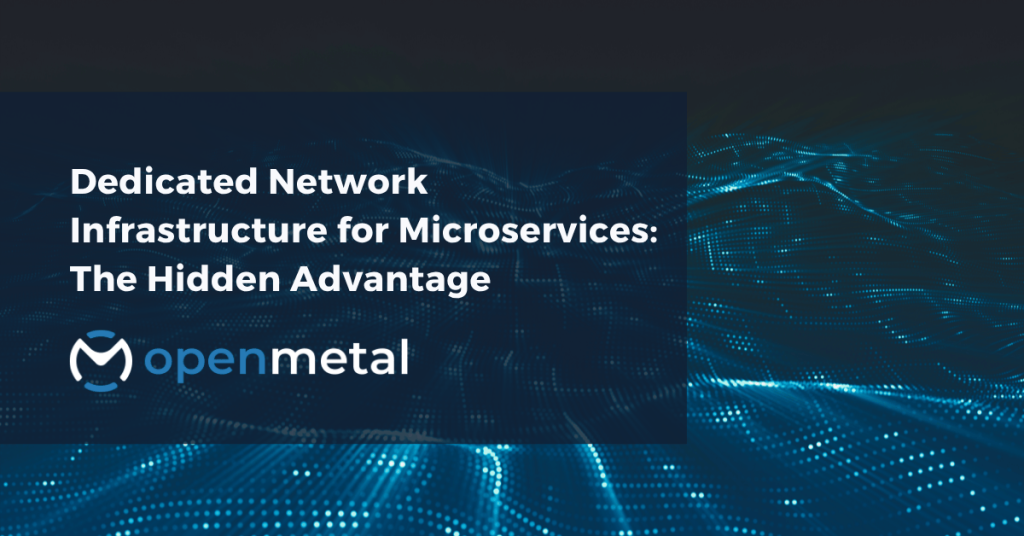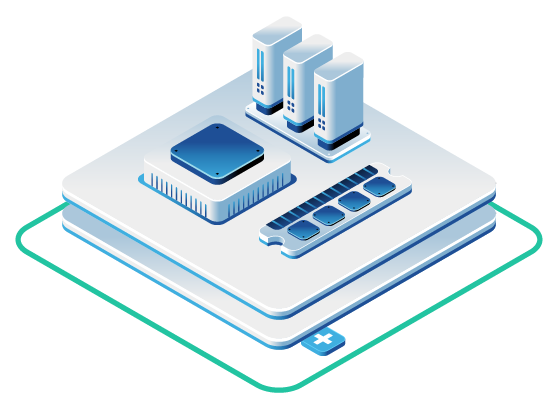
Ready to see how predictable networking transforms your cloud-native deployments?
The OpenMetal team is standing by to assist you with scoping out a fixed-cost model based infrastructure plan to fit your team’s requirements, budgets, and timelines.
Modern applications don’t run on single servers anymore. Your code is distributed across dozens or hundreds of microservices, each communicating constantly with others to deliver seamless user experiences. This shift to cloud-native architectures has brought incredible flexibility and scalability—but it’s also introduced a new challenge that keeps platform engineers up at night: unpredictable network performance.
When you’re building Kubernetes clusters, implementing service meshes, or orchestrating complex microservices, one assumption becomes critical—your network needs to behave predictably. Yet in many cloud environments, this predictability simply doesn’t exist. Your carefully crafted quality of service policies can get lost in translation between your application layer and the underlying infrastructure. The result? Latency spikes, throttled connections, and the dreaded “noisy neighbor” effect that can bring priority services to their knees.
Why Developers Care About Network QoS
Quality of service isn’t just a networking concern—it’s fundamental to how you architect modern applications. When you deploy a service mesh like Linkerd or Istio, you’re making explicit decisions about how traffic should flow between your services. You define which workloads are mission-critical, set rate limits to prevent cascade failures, and implement circuit breakers to maintain resilience.
Service meshes address the challenges of microservices by managing traffic between services and adding reliability, observability, and security features uniformly across all services. However, these application-level policies are only effective if your underlying network infrastructure can actually honor them.
Consider a typical scenario: You’re running a payment processing service that needs guaranteed low latency alongside a batch analytics job that can tolerate delays. In Kubernetes, you can classify pods into quality of service classes—Guaranteed, Burstable, and BestEffort—based on their resource requirements. Your payment service gets Guaranteed status with strict CPU and memory limits, while analytics runs as BestEffort.
This works beautifully at the compute layer. But what happens when both services need to communicate across the network? In traditional public cloud environments, your carefully orchestrated QoS policies often stop at the network boundary. The internal fabric operates as a black box, applying its own rules that prioritize provider efficiency over application-level determinism.
The Black Box Problem in Hyperscaler Networks
Public cloud providers have built impressive networking infrastructure, but it’s designed to serve millions of tenants efficiently—not to give individual developers granular control over traffic flows. This creates several pain points that directly impact your application’s behavior.
Hidden Throttling and Opaque Policies
You set bandwidth limits in your Kubernetes manifests, but you have no visibility into how the underlying network actually enforces them. The noisy neighbor effect occurs when an application or virtual machine uses the majority of available resources and causes network performance issues for others on the shared infrastructure. Your mission-critical API might suddenly experience increased latency not because of your code, but because another tenant’s workload is saturating shared network resources.
When one tenant uses all of the system’s resources at peak times, any requests that another tenant makes may fail, causing the total resource demand to exceed the capacity of the system. You can’t predict when this will happen, and you often can’t diagnose it when it does.
The East-West Traffic Tax
In microservices architectures, most traffic flows between services within your cluster—what networking professionals call “east-west” traffic. A single user request might trigger dozens of internal service calls. In hyperscaler environments, this creates a double problem.
First, you pay for internal bandwidth. Every byte that travels between your microservices potentially incurs charges, making “chatty” architectures—which are often the most resilient and maintainable—prohibitively expensive at scale.
Second, internal traffic competes for the same network resources as external traffic. Your service mesh might be trying to perform health checks and distributed tracing, but these operations get throttled just like any other network activity. You end up choosing between observability and cost efficiency.
Lost Developer Intent
Microservices complicate resource management, as dependencies between them introduce backpressure effects and cascading QoS violations. When you can’t control how network resources are allocated, your application-level policies become suggestions rather than guarantees.
You might configure your Kubernetes pods with specific network policies, set up traffic prioritization in your service mesh, and implement careful rate limiting—but if the underlying network doesn’t respect these configurations, you’re building on quicksand. The gap between what you tell your application to do and what the infrastructure actually does grows wider.
OpenMetal’s Developer-Centric Networking Model
What if your network infrastructure worked the way developers actually think? What if you could align network configuration directly with application architecture, ensuring that QoS policies map cleanly to reality?
This is where OpenMetal diverges from traditional hyperscalers. At OpenMetal, private cloud networking is designed with transparency and developer-level control as core principles, not afterthoughts.
Dedicated Infrastructure Eliminates Guesswork
OpenMetal provides dedicated hardware clusters where the entire network fabric is isolated per customer. This isn’t just marketing—it’s a fundamental architectural difference. Each environment comes with 20 Gbps (dual 10Gbps) NICs and private networking included, giving you full control over how traffic flows through your infrastructure.
When you set bandwidth limits in your application configuration, those limits are actually enforced at the hardware level. There’s no hidden oversubscription, no mysterious throttling, no competing with unknown neighbors for resources. The network performs exactly as you configure it.
VLANs and VXLANs That Match Your Architecture
Modern applications are logically segmented—you have production and staging environments, public-facing services and internal APIs, high-priority transactions and background jobs. OpenMetal supports this reality through VLAN and VXLAN segmentation that you control directly.
You can architect your network topology to mirror your application topology. Priority services get dedicated network segments with guaranteed throughput. Secondary workloads run on separate segments where they can’t interfere with mission-critical traffic. Your service mesh policies translate directly into network-level enforcement.
This isn’t just about isolation—it’s about giving you the power to shape traffic flows according to your application’s needs rather than adapting your application to fit the network’s constraints.
Free Internal Traffic Changes the Economics
Perhaps the most developer-friendly aspect of OpenMetal’s networking model is simple: internal traffic is free. You can deploy chatty service meshes without cost anxiety. Your microservices can communicate as frequently as they need to. Distributed tracing, health checks, service discovery—all the patterns that make cloud-native applications resilient—don’t come with bandwidth charges.
This changes how you make architectural decisions. Instead of choosing between doing things the right way and keeping costs manageable, you can focus purely on building resilient systems. Service meshes have become key components of cloud native infrastructures, with 70% of organizations running them in production or development—and with OpenMetal, you can implement them without watching the meter spin.
Practical Example: Microservices at Scale
Let’s walk through how this works in practice. Imagine you’re building an e-commerce platform with distinct service tiers:
Critical Services (Guaranteed QoS)
- Payment processing API
- Inventory management
- User authentication
- Order placement
Standard Services (Burstable QoS)
- Product recommendations
- Search functionality
- Image processing
- Email notifications
Background Services (BestEffort QoS)
- Analytics aggregation
- Log processing
- Data backups
- Report generation
In a typical public cloud setup, you configure these QoS classes in Kubernetes, but you’re at the mercy of the underlying network. During peak traffic, your background analytics job might saturate available bandwidth, causing latency spikes in payment processing—even though payments should have priority.
With OpenMetal’s dedicated networking, you implement this differently:
- Network Segmentation: Critical services run on a dedicated VLAN with reserved bandwidth. Standard services share another VLAN with defined limits. Background services get whatever’s left over.
- Traffic Shaping: You configure rate limits that actually work because you control the entire network stack. Payment processing gets guaranteed 5 Gbps with burst capability. Analytics is capped at 2 Gbps.
- Predictable Latency: Your service mesh can enforce circuit breakers and timeouts based on real network behavior, not unpredictable variations. You know exactly how long a cross-service call will take under normal conditions.
- Cost-Effective Scale: As you add more microservices, internal communication costs don’t explode. You can implement proper service decomposition without financial penalties.
The result? Your application behaves exactly as designed. Developers can reason about performance characteristics with confidence. Platform engineers can troubleshoot issues based on actual network behavior rather than guessing what’s happening inside a black box.
Networking as Code: A Different Philosophy
OpenMetal approaches networking the same way modern developers approach infrastructure—as something you define, version, and control through code. This isn’t about giving you a fancier dashboard or more monitoring metrics. It’s about fundamentally changing the relationship between application logic and network behavior.
When you deploy on OpenMetal, you’re not adapting to infrastructure constraints. You’re molding the infrastructure to match your application’s requirements. Your QoS policies aren’t aspirational—they’re enforceable guarantees backed by dedicated hardware.
This matters because predictability is the new scalability. Kubernetes QoS ensures efficient resource allocation by categorizing pods based on their importance and preventing resource contention. But that efficiency only matters if you can trust the underlying network to honor these categories consistently.
Compare this to hyperscaler environments where you’re essentially renting time on shared infrastructure optimized for provider efficiency. You get flexibility and massive scale, but you sacrifice control and predictability. For applications where performance matters—and in 2025, that’s most applications—this tradeoff increasingly doesn’t make sense.
Making the Right Choice for Cloud-Native Workloads
The decision isn’t whether to use cloud infrastructure—that ship has sailed. The question is which cloud model aligns with how you actually build and operate applications.
If you’re running stateless web services with forgiving performance requirements, public cloud’s opacity might not matter. But if you’re building systems where latency affects revenue, where compliance requires demonstrable control, or where you need to debug performance issues without reverse-engineering black boxes, OpenMetal’s transparent networking model becomes increasingly attractive.
Modern development practices emphasize observability, testability, and predictability. Your CI/CD pipeline needs reliable performance characteristics to validate deployments. Your monitoring systems need to understand whether performance variations come from your code or the infrastructure. Your on-call engineers need to diagnose issues without filing support tickets and waiting for responses.
OpenMetal’s networking model supports this reality. You get the flexibility and automation of cloud infrastructure combined with the control and predictability of dedicated resources. Your developers can focus on application logic knowing that the network will behave as configured. Your platform engineers can implement sophisticated traffic management knowing it will actually work.
The Path Forward
Cloud-native development continues to evolve, but one principle remains constant: infrastructure should serve applications, not constrain them. As microservices architectures become more sophisticated and service meshes more prevalent, the gap between developer intent and infrastructure behavior becomes more problematic in traditional cloud environments.
OpenMetal bridges this gap by treating networking as something developers should control, not endure. With dedicated hardware, transparent policies, and economics that encourage proper architecture rather than cost-driven compromises, you can build cloud-native applications that perform predictably at scale.
The future of cloud infrastructure isn’t about choosing between control and flexibility. It’s about platforms that provide both—giving you the automation and scalability of public cloud with the determinism and transparency of dedicated infrastructure. That’s what predictable network performance for Kubernetes looks like, and it’s what modern applications deserve.
OpenMetal’s private cloud infrastructure gives you dedicated 20 Gbps networking, transparent QoS controls, and free internal traffic—so your application policies actually work as designed. Ready to find out more?
Read More Blog Posts
Works Cited
- “Noisy Neighbor Antipattern.” Microsoft Azure Architecture Center, learn.microsoft.com/en-us/azure/architecture/antipatterns/noisy-neighbor/noisy-neighbor. Accessed 8 Oct. 2025.
- “Service Mesh.” Cloud Native Glossary, Cloud Native Computing Foundation, 23 May 2025, glossary.cncf.io/service-mesh/. Accessed 8 Oct. 2025.
- “Service Meshes Are on the Rise – But Greater Understanding and Experience Are Required.” Cloud Native Computing Foundation, 17 May 2022, www.cncf.io/blog/2022/05/17/service-meshes-are-on-the-rise-but-greater-understanding-and-experience-are-required/. Accessed 8 Oct. 2025.
- “What Is Noisy Neighbor (Cloud Computing Performance)?” TechTarget, www.techtarget.com/searchcloudcomputing/definition/noisy-neighbor-cloud-computing-performance. Accessed 8 Oct. 2025.
- Zhang, Yanqi, et al. “Sinan: Data-Driven, QoS-Aware Cluster Management for Microservices.” arXiv, 27 May 2021, arxiv.org/abs/2105.13424. Accessed 8 Oct. 2025.


































